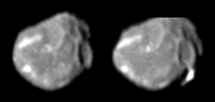അമാൽത്തിയ
 Greyscale Galileo images of Amalthea | |||||||||
| കണ്ടെത്തൽ | |||||||||
|---|---|---|---|---|---|---|---|---|---|
| കണ്ടെത്തിയത് | E.E. Barnard | ||||||||
| കണ്ടെത്തിയ തിയതി | September 9, 1892 | ||||||||
| വിശേഷണങ്ങൾ | |||||||||
| Adjectives | Amalthean | ||||||||
| ഭ്രമണപഥത്തിന്റെ സവിശേഷതകൾ | |||||||||
| Periapsis | 181150 km[i] | ||||||||
| Apoapsis | 182840 km[i] | ||||||||
പരിക്രമണപാതയുടെ ശരാശരി ആരം | 181365.84±0.02 km (2.54 RJ)[1] | ||||||||
| എക്സൻട്രിസിറ്റി | 0.00319±0.00004[1] | ||||||||
| 0.49817943±0.00000007 d (11 h, 57 min, 23 s)[1] | |||||||||
Average പരിക്രമണവേഗം | 26.57 km/s[i] | ||||||||
| ചെരിവ് | 0.374°±0.002° (to Jupiter's equator)[1] | ||||||||
| ഉപഗ്രഹങ്ങൾ | Jupiter | ||||||||
| ഭൗതിക സവിശേഷതകൾ | |||||||||
| അളവുകൾ | 262 × 146 × 128 km[2] | ||||||||
ശരാശരി ആരം | 83.5±2.0 km[2] | ||||||||
| വ്യാപ്തം | (2.43±0.22)×106 km3[3] | ||||||||
| പിണ്ഡം | (2.08±0.15)×1018 kg[3] | ||||||||
ശരാശരി സാന്ദ്രത | 0.857±0.099 g/cm³[3] | ||||||||
| ≈ 0.020 m/s² (≈ 0.002 g)[i] | |||||||||
| ≈ 0.058 km/s[i] | |||||||||
| synchronous[2] | |||||||||
| zero[2] | |||||||||
| അൽബിഡോ | 0.090±0.005[4] | ||||||||
| |||||||||
| 14.1[5] | |||||||||
വ്യാഴത്തിന്റെ ഉപഗ്രഹമാണ് അമാൽത്തിയ(Amalthea). വ്യാഴത്തിന്റെ ഏറ്റവും സമീപത്തുള്ള മൂന്നാമത്തെ ഉപഗ്രഹമാണിത്.
1892 സെപ്റ്റംബർ 9 നു എഡ്വാർഡ് എമേർസൺ ബർണാഡ് ആണ് ഈ ഉപഗ്രഹത്തെ കണ്ടെത്തിയത്.ഗ്രീക്ക് പുരാണത്തിലെ ദേവതയായ അമാൽത്തിയയുടെ പേരാണ് ഈ ഉപഗ്രഹത്തിനു നൽകിയത് .[7]
Notes[തിരുത്തുക]
അവലംബം[തിരുത്തുക]
Cited sources
- doi:10.1126/science.1110422
This citation will be automatically completed in the next few minutes. You can jump the queue or expand by hand - doi:10.1086/101715
This citation will be automatically completed in the next few minutes. You can jump the queue or expand by hand - doi:10.1126/science.284.5417.1146
This citation will be automatically completed in the next few minutes. You can jump the queue or expand by hand - Burns, Joseph A.; Simonelli, Damon P.; Showalter, Mark R.; Hamilton, Douglas P.; Porco, Carolyn C.; Throop, Henry; Esposito, Larry W. (2004). Bagenal, Fran; Dowling, Timothy E.; McKinnon, William B. (eds.). Jupiter's Ring-Moon System (PDF). Cambridge University Press. pp. 241–262. Bibcode:2004jpsm.book..241B. ISBN 978-0-521-81808-7.
{{cite encyclopedia}}:|journal=ignored (help) - doi:10.1016/j.icarus.2005.11.007
This citation will be automatically completed in the next few minutes. You can jump the queue or expand by hand - Flammarion, Camille (1893). "Le Nouveau Satellite de Jupiter". L'Astronomie. 12: 91–94. Bibcode:1893LAstr..12...91F.
{{cite journal}}: CS1 maint: ref duplicates default (link) - "Another Find for Galileo". Jet Propulsion Laboratory. 9 April 2003. Retrieved 2012-03-27.
- Marsden, Brian G. (October 7, 1975). "Satellites of Jupiter". IAU Circular. 2846. Retrieved 2012-03-27.
- Observatorio ARVAL (April 15, 2007). "Classic Satellites of the Solar System". Observatorio ARVAL. Retrieved 2011-12-17.
- doi:10.1016/0019-1035(83)90244-0
This citation will be automatically completed in the next few minutes. You can jump the queue or expand by hand - doi:10.1006/icar.2000.6474
This citation will be automatically completed in the next few minutes. You can jump the queue or expand by hand - "Swiss Cheese Moon: Jovian Satellite Full of Holes". Space.com. 9 December 2002. Archived from the original on 2008-08-28. Retrieved 2014-09-24.
- doi:10.1126/science.1105427
This citation will be automatically completed in the next few minutes. You can jump the queue or expand by hand - doi:10.1006/icar.1998.5976
This citation will be automatically completed in the next few minutes. You can jump the queue or expand by hand - USGS/IAU. "Amalthea Nomenclature". Gazetteer of Planetary Nomenclature. USGS Astrogeology. Retrieved 2012-03-27.
External links[തിരുത്തുക]
Amalthea എന്ന വിഷയവുമായി ബന്ധപ്പെട്ട ചിത്രങ്ങൾ വിക്കിമീഡിയ കോമൺസിലുണ്ട്.
- Amalthea Profile Archived 2014-10-09 at the Wayback Machine. by NASA's Solar System Exploration
- Amalthea nomenclature from the USGS planetary nomenclature page
- Jupiter's Amalthea Surprisingly Jumbled – JPL press release (2002-12-09)
- Jupiter From Amalthea, a painting by Frank Hettick, 2002.
